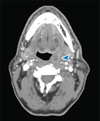HPV-Associated Head and Neck Cancer: Unique Features of Epidemiology and Clinical Management
- PMID: 26332002
- PMCID: PMC5242186
- DOI: 10.1146/annurev-med-051914-021907
HPV-Associated Head and Neck Cancer: Unique Features of Epidemiology and Clinical Management
Abstract
Human papillomavirus (HPV) is a recently identified causative agent for a subset of head and neck cancers, primarily in the oropharynx, and is largely responsible for the rising worldwide incidence of oropharyngeal cancer (OPC). Patients with HPV-positive OPC have distinct risk factor profiles and generally have a better prognosis than patients with traditional, HPV-negative, head and neck cancer. Concurrent chemotherapy and radiation is a widely accepted primary treatment modality for many patients with HPV-positive OPC. However, recent advances in surgical modalities, including transoral laser and robotic surgery, have led to the reemergence of primary surgical treatment for HPV-positive patients. Clinical trials are under way to determine optimal treatment strategies for the growing subset of patients with HPV-positive OPC. Similarly, identifying those patients with HPV-positive cancer who are at risk for recurrence and poor survival is critical in order to tailor individual treatment regimens and avoid potential undertreatment.
Keywords: human papillomavirus; oropharyngeal cancer; oropharyngeal squamous cell carcinoma.
Figures



References
-
- Munoz N, Bosch FX, de Sanjose S, et al. Epidemiologic classification of human papillomavirus types associated with cervical cancer. N. Engl. J. Med. 2003;348:518–527. - PubMed
-
- Gillison ML, Koch WM, Capone RB, et al. Evidence for a causal association between human papillomavirus and a subset of head and neck cancers. J. Natl. Cancer Inst. 2000;92:709–720. - PubMed
-
- Ryerson AB, Peters ES, Coughlin SS, et al. Burden of potentially human papillomavirus-associated cancers of the oropharynx and oral cavity in the US, 1998–2003. Cancer. 2008;113:2901–2909. - PubMed
Publication types
MeSH terms
Substances
Grants and funding
LinkOut - more resources
Full Text Sources
Other Literature Sources

